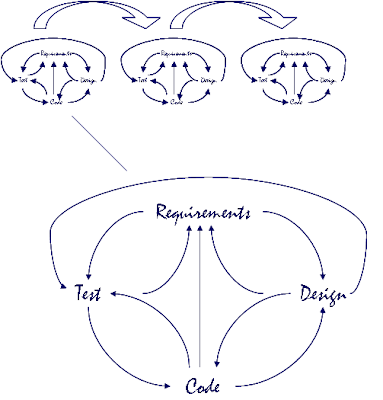While both models appear may similar (both are iterative and consist of requirements, design, coding ,and testing activities) there are significant differences that make them completely different animals. If we were to simply follow a waterfall based approach with small iterations then the flow of activities within an iteration would like look this:
 As everyone is probably familiar with, this is the mini-waterfall (waterfalls within an iteration). The developers and customers follow a sequential set of activites as prescribed by the waterfall model. The flow of work is predictive and follows a set path. While this model is iterative it is not agile. Why? The reason is because an agile model will support continuous learning and refinement not only between iterations but also within iterations. It does this by intertwining the requirements, designing, coding, and testing together into an unpredictable flow of work.
As everyone is probably familiar with, this is the mini-waterfall (waterfalls within an iteration). The developers and customers follow a sequential set of activites as prescribed by the waterfall model. The flow of work is predictive and follows a set path. While this model is iterative it is not agile. Why? The reason is because an agile model will support continuous learning and refinement not only between iterations but also within iterations. It does this by intertwining the requirements, designing, coding, and testing together into an unpredictable flow of work.
The developers and customers jump back and forth from one activity to another in an unpredictable manner. There is no set path. Instead, as they start implementing a user story or use case, they may discover new insights that require them to revisit and redefine their initial set of requirements which require them to redesign the solution, create or rewrite tests and code. Iterative learning and change is enabled within each iteration. This allows the developers and customers to quickly and easily react to change and stay agile.
So, if you are doing agile right now ask yourself which model your using and if you are not doing the second model then I strongly urge you to try it out. You will find that the agile practices fit better and allows your team to fluidly move from one activity to another. Remember, you are not doing agile if your team isn't continuously learning and able to react to the new knowledge.
Can't you at least spell your title correctly?
ReplyDeleteTo: Anonymous
ReplyDeleteHlleo! It has been fuond taht olny litlte kdis tlak abuot spellign erors in bolgs. As logn as you can undrestnad what I am syaing, you have grwon up. Else, "go back to school kid" in yuor own wrods.
now that was just too funny...
ReplyDelete